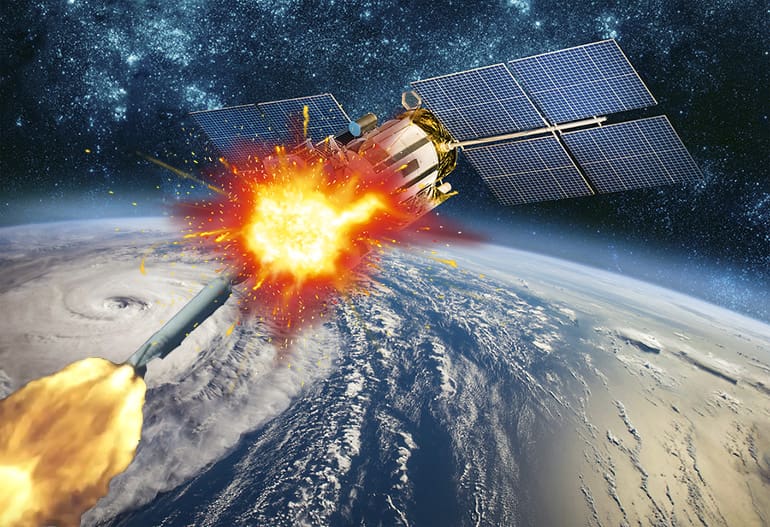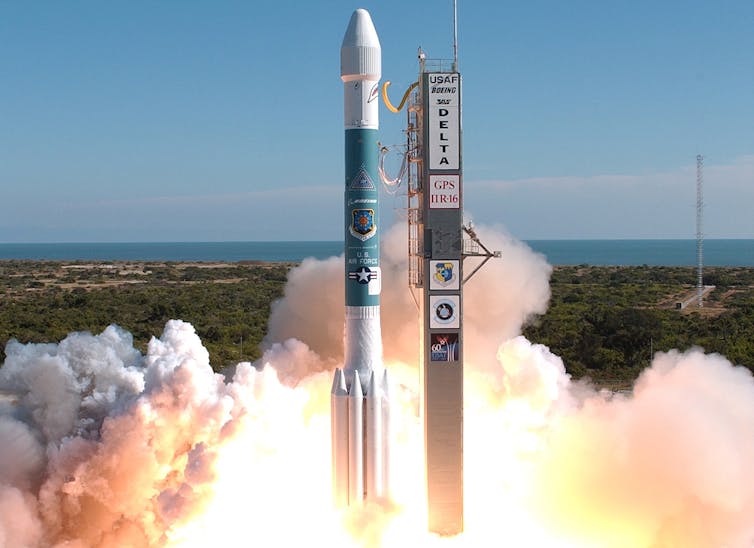By Gareth Dorrian, University of Birmingham and Ian Whittaker, Nottingham Trent University
At an upcoming summit in early December, NATO is expected to declare space as a “warfighting domain”, partly in response to new developments in technology.
If it does declare space a war zone, NATO could start using space weapons that can destroy satellites or incoming enemy missiles. But what is this technology and how could it enable a war?
In a recent first for space technology, Russia has launched a commercial satellite specifically designed to rendezvous with other satellites. The purpose of this vehicle is peaceful: it will perform maintenance tasks on other satellites in orbit.
The fact that commercial companies have this capability probably means that it already exists for global military powers. This has caught the attention of NATO. If a country or company can manoeuvre its own satellites into close proximity of others, then it can do so for military or sabotage purposes – potentially without detection.
Another development is France’s recent announcement that it will build “bodyguard” satellites armed with either machine guns or lasers. This follows an announcement that the US will launch a space force in 2018. Many other nations may soon follow suit.
Electronic warfare
But how would sabotage and warfare happen exactly? One method involves firing an intense beam of microwave radiation at an object. In fact, such concepts have been tested before by the police as a means of bringing a speeding car to a halt by disabling electrical devices on the vehicle.
Such a concept deployed on satellites would constitute a “directed-energy weapon”, enabling nations to disable other countries’ satellites without creating large clouds of orbital debris. You could potentially make such an attack look like an accident and deny involvement.
The use of “radio jamming” to disrupt radar and communications dates back to World War II. By swamping a radio receiver with, effectively, radio noise, one can obscure the reception of genuine signals and render the system inoperative. This is a little like trying to spot the light from a candle against the glare of car headlights.
Satellites are thoroughly tested for self generated radio noise before going into space. But if a “hostile” satellite nearby were to deliberately direct broadband radio transmissions at the target satellite, then communications could be completely disrupted.
Space-based electronic warfare is likely to become an increasing concern for military planners. In fact, many military services on Earth now depend on space technology to work.
Kinetic kills and lasers
By far the most obvious method of interfering with a satellite is a solid projectile. Moving satellites have very high kinetic energy and momentum. If a slower moving object can be placed briefly in the path of a satellite, then the resultant collision will be particularly devastating.
These so called “kinetic kills” have previously only been used to take satellites out of commission at the end of their life, with the US, Russia China, and India demonstrating their ability to perform this. This type of removal consists of a ground-launched missile aimed at the satellite. If aimed at an adversary satellite, such a missile would be fairly obvious and could be tracked by other nations using radar.
A more subtle method would be to destroy a satellite owned by the country or company launching the missile and aim to produce as much debris as possible, which then lies in the orbital path of the intended target. This could look like an accident and actually accidently occurred in 2007.
As far as kinetic weapons in space are concerned, machine guns are generally problematic due to the recoil involved. If the weapon is fired at any angle which is not in the exact direction of the orbital path the satellite is travelling along, then a torque will be applied, rapidly changing the direction of it. The idea of kinetic weapons has been attempted before. The Soviet space station Salyut-3, for example, was armed with a rapid fire cannon in the mid 1970s.
Lasers are also being considered as defensive weapons, with the idea being to take out attacking satellites’ solar panels. With no power, the satellite will be unable to communicate with the ground station and is essentially lost. The recoil from a laser is much smaller and the lack of atmosphere would allow them to perform better than on the Earth’s surface.
A laser could be used to blind instrumentation on an opposing satellite thereby reducing the efficacy of either rendezvous or aiming software.
The most likely satellites to be targeted would be those dedicated to communication or observing. With the newest research satellites able to take images down to a 30cm resolution, military versions are likely to be even better. A nation with no communication facilities or ability to observe others will never know who has launched an attack against them.
But what would a space war look like from Earth? While sci-fi films have conditioned us to believe that space lasers would use visible light, shorter wavelengths actually produce more power. Any observers on the surface would be unlikely to directly see any effects from space warfare, unless a kinetic kill actually breaks a spacecraft up – with debris lighting up as it re-enters the atmosphere. That said, attacks could still affect our lives on Earth, disturbing GPS, television services and even cash withdrawals.
Nuclear weapons?
The use of nuclear weapons and weapons of mass destruction in space is currently banned under the Outer Space Treaty and the Comprehensive Nuclear-Test Ban Treaty. But not all nuclear armed nations have ratified the latter, including the US and North Korea.
A small number of nuclear tests in space were conducted in the 1960s including Starfish Prime. These resulted in artificial radiation belts forming around the Earth which were still detectable decades after the event – posing a danger for astronauts.

These radiation belts also disabled half a dozen satellites in low Earth orbit. If the results of Starfish Prime are anything to go by, then clearly it would take only a handful of nuclear detonations to make space unusable for any satellites for decades to come.
Given the options now becoming available, it seems important to remember that, under the Outer Space Treaty, space is supposed to be used only for peaceful purposes and remain the domain of “all mankind”.![]()
Gareth Dorrian, Post Doctoral Research Fellow in Space Science, University of Birmingham and Ian Whittaker, Lecturer in Physics, Nottingham Trent University
This article is republished from The Conversation under a Creative Commons license. Read the original article.






I’m sure that there are already some “weather satellites” up there. This is just putting ink to paper and making it official.
Kinetic weapons? Imagine all the debris in orbit whizzing around at speeds that would enable a paper-clip piece of material to destroy or fully disable a satellite. The only feasible strategy I’ve ever read about weapons for space deployment are lasers that heat up a target enough to affect its trajectory, eventually causing its orbit to decay and result in the target burning up in the atmosphere upon re-entry. That way, all debris would return to the surface.
A kinetic impact would just send particles all over the place and affect our ability to safely use other non-military satellites.
“shorter wavelengths actually produce more power”
Sigh.
Yeah, call me when the energy storage density, wallplug efficiency and waste-heat disposal systems are good enough to be practical. We’ll go over the other physics confusion then.
And he doesn’t even mention the Gyro-Jet, the original design for a (nominally) practical space gun.
Boy, is that some old BS. Your AR-15 in 5.56 will work fine in space with minor sight adjustments (no bullet drop, infinite range), the gyrojet was designed for underwater use.
Yes and no. It’ll fire and cycle. However, you are quickly going to start spinning, fast, as you shoot it (and get pushed reward, but more imparted spin than push). Unless you are anchored and then whatever you are anchored to is going to suffer torque and begin to spin. Now, something like a space station probably isn’t going to noticeably spin even emptying an entire mag (not on the time scale of RPM, more like RPH).
You wouldn’t have zero bullet drop. You are in orbit, which means the bullet is following an orbital trajectory modified by the velocity of the bullet and the angle relative to the orbit. If you aimed straight at a satellite in the same orbit trailing 10km behind you, you’d miss. The bullet would “climb” or “fall” relative to the satellite because you just shoved the bullet in to an elliptical orbit ~1km/sec faster or slower than the one you were in. Over a short range it would make no difference, but over a range of hundreds of meters and certainly kilometers you’d have to account for orbital mechanics or you WILL miss.
A gyro jet isn’t zero recoil, but it is significantly less recoil.
One thing to mention on nukes in orbit, unless or until we withdraw from the Space treaty, no nukes in orbit. The treaty bans the militarization of space as defined as weapons of mass destruction in orbit. A nuke sure qualifies. Rods from god may or may not. Probably on an international court to decide (as in, no one is being stopped from doing it because they’ll just ignore any international court ruling).
Orbital laser weapons are maybe the most useful and safest ASAT space based weapons. A few hundred KW laser probably could disable another satellite if it passes reasonably close (within a couple hundred kms). However, distances are vast even in orbit and for a hard kill you’d need at least single digit megawatt laser, if not in to the scores of MW. Which just isn’t feasible in orbit.
Not a single mention of kessler syndrome? Warfare in orbital space is an extension of MAD. Hit the tipping point and NO ONE gets access to space for a long long time.
“Not a single mention of kessler syndrome?”
Most of those birds are in low earth orbit. Atmospheric drag naturally cleans LEO all on it’s own over time…
Geosynch is also pretty crowded, and extremely useful and valuable orbital territory. It wouldn’t be self-clearing very fast.
For all practical purposes for the satellites up there in geosynch, the orbital velocity is *zero* (it really isn’t, but they are, with respect to each other). So Kessler doesn’t really apply up that high. LEO is an entirely different critter, you have equatorial orbits mixed in with some polar orbits, a much higher chance of orbital ‘conflicts’…
Geoff, the relative velocities are small because most of the satellites out there are in nearly identical geosynch orbits albeit with different longitude … 24 hour orbital period at or near the equatorial plane. You can have that period of orbit in any other orientation, e.g. polar, at which point the relative velocities aren’t that small any more.
I think the point here, though, is that if one starts a Kessler Cascade, any spacecraft is going to need to be hardened if it has any chance for long term survival. Or we’ll need to do debris clearing. Or both. Granted the LEO space will self clean to an extent, but the rate of cleaning goes down quickly as perigee increases.
“The most likely satellites to be targeted would be those dedicated to communication or observing.”
Yup, and that makes SpaceX’s new 12,000 orbital satellite internet constellation a *highly* valuable national security asset for the US.
12,000 individual targets make it a lot tougher to knock out :
“Musk’s satellite project testing encrypted internet with military planes”
https://www.reuters.com/article/us-spacex-starlink-airforce/musks-satellite-project-testing-encrypted-internet-with-military-planes-idUSKBN1X12KM
Oh, and SpaceX is making noises they want to expand it to a total of 40,000 satellites :
https://spacenews.com/spacex-submits-paperwork-for-30000-more-starlink-satellites/
That’s gonna take some serious effort by China or Russia to kill… 🙂
Eh. Start a debris cascade around some of the more popular / crowded orbits and the rest will happen all by itself.
The variables here are how fast you want or need it done, and to what level of disruption. Taking 100% of 20-40k satellites out in a couple of minutes would be a challenge. (Unless, perhaps, you use nukes.) But if you can wait a day for 95%+ effective kills…?
They also have assets up there in the same neighborhood. It’s a Mexican standoff situation…
“The Right To Keep And Bear Arms” in space “Shall Not Be Infringed”,be the first on your block to get yours.
Man is hard wired to be violent and aggressive. It’s what we do. Our tech changes but we remain the same naked savage.
No amount of soy is going to change that.
A few decades ago there was also a project which explored the feasibility of putting 1 gigaton nuclear bombs in space. To be used in space warfare to be used on asteroids. I imagine a 1 gigaton nuclear explosion in space would look like a second small sun in the sky to us on earth.
Mo’ guns = mo’ bettah.
Mo Bettah makes great Hawaiin food!
Ya’ think?
Resolution is nothing more than a function of aperture. The bigger the lens/mirror, the more detail you can see at a given distance.
We already launched the Hubble Space Telescope based on late 1980s and early 1990s technology. I am confident that our military could launch something better 20 years later (which would be some time between 2008 and 2013).
My understanding is that they’re basically Hubble cousins. Size is limited by the launch platforms, so bigger than Hubble isn’t easy. The internals would be different, with something like active mirrors to compensate for atmospheric disturbances, which isn’t an issue for Hubble.
Yup, a spare mirror from a Keyhole (KH) series recon ‘bird’ re-ground (flattened) to focus at infinity.
Fun trivia, the *reason* that quality control didn’t catch the grinding error that made the images ‘blurry’ was that the mirror factory was so high security (NSA) the Hubble people weren’t allowed inside to check the mirror’s ‘figure’ (exact shape). They had to trust that it was correct.
We got lucky that the factory hadn’t gotten around yet to dismantling the test jig that measured the mirror’s shape. So, they were able to precisely measure the test jig itself and calculate the shape of the corrective lenses. Thank God for the lazy American factory workers, eh? 😉
I’m going to assume the authors are a couple of tyro’s of less than 35 to 40 years old.
Because all of this was analyzed (extensively) by engineers back in the mid-80’s. SDI – the Reagan defense initiative that bankrupted the USSR trying to keep up with our Buck Rogers ideas and even bigger plans for space – had all of these elements in it. There were rocket-on-rocket killing ideas – hyperfast rockets with very fast computing and signal processing (the computing and signal processing weren’t quite up to snuff yet in the late 80’s – but the Patriot anti-missile system used the same ideas, scaled down in time/space), there were “brilliant pebbles,” X-ray lasers, you name it. It was all in SDI.
XRay lasers:
https://www.osa-opn.org/home/articles/volume_19/issue_5/features/the_history_of_the_x-ray_laser/
Brilliant Pebbles:
http://highfrontier.org/january-8-2019-brilliant-pebbles-is-affordable/
Kill-sats:
https://www.popularmechanics.com/space/satellites/a9620/the-hidden-history-of-the-soviet-satellite-killer-16108970/
Fighter-launched ASAT missile:
https://en.wikipedia.org/wiki/ASM-135_ASAT
BTW, there was other research ongoing in this vein in the 60’s, only it used a F-104 Starfighter as the launch vehicle. The F-104 could climb to over 100,000′ ASL.
I won’t get into the huge effort expended in the SAGE program.
What has changed? We enriched the communist Chinese with our “free trade” mental masturbation, that’s what.
I miss the days of Robert Farago and TTAG content circa 2012.
All the more reason to be prepared on the ground for when communication goes out.
Your coms may go out, but me and mine won’t.
HAM radio FTW!
I’m the hillbilly Vlad warned you about.
I might just shoot down all the satellites if them boys don’t play nice. I got me a 6.5 creedmoor and I ain’t skeered to use it! Might get some of them aliens too, I hear they taste a bit like groundhog.
Bet there are already a few weapons satellites already up there among the space junk that are just playing possum.
Red Storm Rising is a book written by Tom Clancy in 1986, and in it, a pilot shoots down a satellite with a missile. Meaning we had that warfighting doctrine at least as long as we’ve had satellites.
This isn’t new.
Powered by Linux? They’ll have more friends now…
https://www.youtube.com/watch?v=9GO3mccvTCs
Comments are closed.